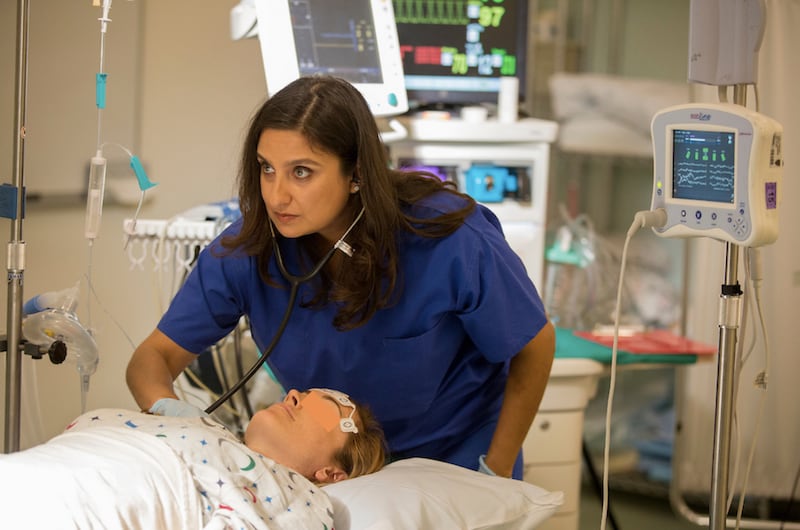To many, Dr Divya Chander stands as a trailblazer in the evolving neuroscience landscape, delving deep into the intricacies of consciousness.
Speaking to The National at the Global AI Show held in Dubai, her research underscores the transformative potential of technology in unravelling the mysteries of the brain.
Describing herself as a “science fiction writer but in the body of an actual scientist and doctor”, Dr Chander's work offers insights into the complexities of the human mind and the implications of technological advancements in neuroscience.
She began exploring neural networks that support shifts in states of consciousness about a decade ago.
Using cutting-edge technology such as optogenetics and EEG electrodes, Dr Chander meticulously examines brain activity during transitions from consciousness to unconsciousness.
This approach has provided insights into developing algorithms to detect changes in consciousness to ward off brain failure and mitigate the risk of conditions such as dementia.
“I've been involved with mapping consciousness for almost a decade now, focusing on the neural networks that lead to consciousness-state switches,” Dr Chander said.
Challenges and opportunities in IoT
Dr Chander uses the Internet of Medical Things (IoMT) and cloud technology for her research. Despite the potential of IoMT devices, she acknowledges challenges in their widespread adoption, particularly in risk-averse environments such as hospitals.
However, she points out that consumers are increasingly embracing wearable devices, blurring the lines between passive IoT gadgets and active medical monitors.
“Some of these things might just be passive IoT devices, and sometimes they are being used to collect medical data,” she said.
Even devices that run Alexa, Amazon's virtual assistant technology, can record your voice and passively diagnose you biometrically, she said.
Advances in computing power have played a pivotal role in Dr Chander's research, supporting the use of complex algorithms. Such innovation enhances data security and enables real-time monitoring and analysis, which is crucial for preserving brain health.
“Advancements in bioelectronics and computing power are enabling us to deploy algorithms that might otherwise have been a little bit more complicated to deploy,” she said.
Transformative role of AI
Reflecting on the transformative impact of artificial intelligence in neuroscience, Dr Chander underscores its role in decoding brain signals with unprecedented accuracy.
“AI has revolutionised brain reading by advancing attentional or transformer models, which ultimately gave rise to large language models.”
Using this technology, researchers can read and decode signals in the brain with much higher fidelity and make connections in the brain invasively and non-invasively.
As an example, Dr Chander the technology can translate what someone might see, decode it and extract semantic meaning simultaneously, a feat that was previously unthinkable.
Ethical innovation
Dr Chander emphasised that technological progress enables researchers to read from the brain and write to it, raising concerns about unauthorised access to a person's neural activity. This realisation prompted her to focus on neural rights and the protection of biometric safety.
“The same technologies that are used to read from the brain, which are electrodes, can be used to deliver energy back into the brain,” she said.
She highlighted the concerning potential for neurotechnology to be used to manipulate people, citing the ability to induce false beliefs by increasing brain plasticity and then implanting narratives.
An example involves the creation of a “super soldier”, where one's brain is manipulated to eliminate any aversion to harming others.
This manipulation could programme people to become devoid of empathy, representing a significant ethical concern.
Dr Chander stressed the significance of the neural code, considering it “even more important than the genetic code in defining your personhood”.
“These are your very thoughts. So, this is the thing that defines you,” she said.
Dr Chander's primary goal is to shield people from unwanted manipulation and intrusion into their mental processes, ensuring the right to privacy of thought and neural activity.
Founding Lucidify
Driven by her findings, Dr Chander founded Lucidify, a company that tracks when consciousness levels change.
She focuses on new advancements that eliminate the use of electrodes to increase user comfort and compliance.
“That's important because the more comfortable something is for a human to wear, the more likely they are to utilise that wearable,” she said.
Innovative devices
Lucidify's vision is to develop innovative devices that support and protect brain health.
“Our goal is to transform brainwave data into vital signs, revolutionising neurological monitoring and intervention to enhance the quality of life,” Dr Chander said.
Eventually, she hopes to integrate the devices into smart homes to allow people to age gracefully and prevent opiate overdoses by detecting when the brain is beginning to fail.





